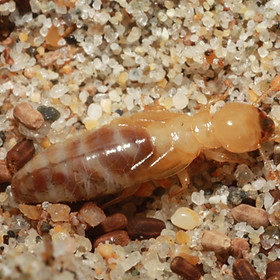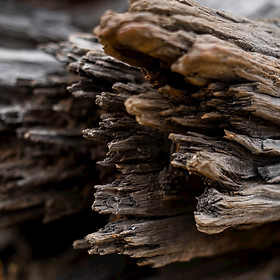


Dampwood termites are not considered to be significant building pests, although they can sometimes cause damage to weathered timber and timber found in severely damp conditions. They require a constant moisture supply and so are generally incapable of sustaining damaging activity in the drier timbers found in buildings.
As such, dampwood termites are better considered as eaters of deteriorating and dead trees, tree stumps, ground poles and offcuts of timber left in contact with the ground during construction works. However, they can be found in wall cavities and beneath houses where the conditions are damp and poorly ventilated.
Dampwood termites also live in smaller, independent groups rather than form a large central colony like subterranean termites.
Request a Booking
Unlike dampwood and subterranean termites, drywood white ants don’t require a constant and reliable water source. They obtain what moisture they need from a humid atmosphere and the content in the timbers they inhabit. Drywood termites are mostly found in tropical climates where temperatures are constant and where the atmospheric humidity is consistently above 75%.
Drywood termites don’t form a central colony, preferring to live in a number of smaller, independent groups. Additionally, they are equally as destructive to buildings as their subterranean counterparts. They can attack structural and joinery timbers, compromising the structural integrity of a property, whilst also feeding on wooden furniture, cabinets and doorframes.
The species Cryptotermes brevis (the West Indian drywood termite) is considered to be the most destructive in the world as they can exist in very small pieces of wood. From these small pieces of wood, the cryptotermes brevis can easily spread to other timbers.
Request a Booking






Subterranean termites ("white ants") are the most devastating type and the biggest threat to buildings in Victoria. What makes them the biggest threat is their appetite for timber. Timber struts, framing, beams, supports, architraves, panelling, floorboards, doors and even plasterboard! You name it; they eat it, and to damaging effects.
Whilst an insect mound is the most familiar and recognisable sign of a nest, subterranean white ants have an entirely underground existence, so their central colony nest can be anywhere in the soil, or in surrounding dead or living trees.
Subterranean termites can travel between 50-100 metres through underground tunnels from their central nest, building mud tunnels, or tubes, into your house to their source of food. These insects then set to work eating the inside of your home’s structure, leaving only a thin protective shell behind, seriously compromising and weakening the structural integrity of your property.
But my home is steel framed, so I’m safe, right? Wrong! White ants can still find their way into steel framed homes, destroying wooden furniture, roof trusses, and any wood trimmings they find inside.
Regular and thorough termite pest control inspections and checks are important to detect, treat and prevent further activity and infestations.
Request a Booking




View Our Areas of Services
Abbotsford, Armadale, Auburn, Balwyn, Bayswater, Berwick, Blackburn, Boronia, Box Hill, Brighton, Burwood, Camberwell, Canterbury, Cranbourne, Cremorne, Croydon, Dandenong, Doncaster, Fairfield, Forest Hill, Frankston, Glen Iris, Glen Waverley, Hawthorn, Kew, Kilsyth, Langwarrin, Mitcham, Mooroolbark, Mount, Mulgrave, Narre Warren, Nunawading, Officer, Pakenham, Ringwood, Rowville, Toorak, Vermont, Wantirna, Windsor


